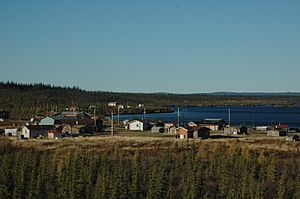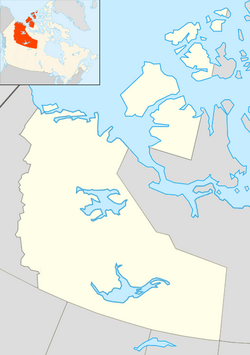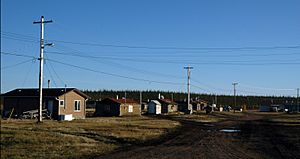Colville Lake, Northwest Territories facts for kids
Quick facts for kids
Colville Lake
K'áhbamį́túé
|
|
|---|---|
|
Settlement Corporation
|
|
 |
|
| Country | Canada |
| Territory | Northwest Territories |
| Region | Sahtu |
| Settlement area | Sahtu |
| Constituency | Sahtu |
| First Nation (Designated Authority) | 30 November 1995 |
| Area | |
| • Land | 128.39 km2 (49.57 sq mi) |
| Elevation | 259 m (850 ft) |
| Population
(2016)
|
|
| • Total | 129 |
| • Density | 1.0/km2 (3/sq mi) |
| Time zone | UTC−07:00 (MST) |
| • Summer (DST) | UTC−06:00 (MDT) |
| Canadian Postal code |
X0E 1L0
|
| Area code(s) | 867 |
| Telephone exchange | 709 |
| - Living cost | 182.5 |
| - Food price index | 196.3 |
| Sources: Department of Municipal and Community Affairs, Prince of Wales Northern Heritage Centre, Canada Flight Supplement 2013 figure based on Edmonton = 100 2015 figure based on Yellowknife = 100 |
|
Colville Lake (K'áhbamį́túé meaning "ptarmigan net place") is a small community in the Northwest Territories, Canada. It is located in the Sahtu Region, about 50 kilometres (31 miles) north of the Arctic Circle. The community sits on a lake of the same name, northeast of Norman Wells. Colville Lake is the main office for the Behdzi Ahda band government. The community likely got its name from Hudson's Bay Company Governor Andrew Colvile.
Contents
How Many People Live in Colville Lake?
In 2021, a study by Statistics Canada counted 110 people living in Colville Lake. This number was a bit lower than the 129 people counted in 2016. The community has a land area of about 126 square kilometres (48.7 square miles).
Most of the people living in Colville Lake are Indigenous, specifically Sahtu Dene. They are part of the Behdzi Ahda' First Nation and the Sahtu Dene Council.
What is the Geography and Climate Like?
Colville Lake is located about 745 kilometres (463 miles) northwest of Yellowknife by air. The land around Colville Lake has many black spruce trees, but they are often small and spread out. You can also find mosses, lichens, grasses, and alders growing there.
The winter months are long, starting in October and lasting until April. May is when spring arrives, and the ice on lakes and rivers begins to melt. By late May or early June, the water is usually clear of ice. Summer months are June, July, and August, with temperatures often around 20-25 degrees Celsius (68-77 degrees Fahrenheit). Sometimes it can even get hotter! By late September, the lakes and rivers start to freeze again.
What is the History of Colville Lake?
Colville Lake is the traditional home of the Hareskin (Sahtu) Dene people. They have lived in this area for a very long time. The Hareskin Dene were not a very large group, with fewer than a thousand people living in several bands when Europeans first arrived. They were known for using small animals like the Arctic hare for food and clothing.
Colville Lake is a very traditional community. Although Father Émile Petitot brought Christianity to the area in 1864, the community really started to organize in 1962. That's when a Roman Catholic mission was set up by Bern Will Brown. Brown came from the US in 1948, first as a priest, and later became known as a painter and bush pilot.
What Can You See and Do Today?
Today, you can visit the site of the "Our Lady of the Snows" mission. A popular spot is a fishing lodge, as Colville Lake is home to fish like grayling, trout, and pike. There is also a small art gallery and museum right next to the lodge. For visitors, there is a bed and breakfast and a retail store in town.
What Services Are Available?
- Food and Post Office: The Kapami Co-op is the only place to buy food and also serves as the community's post office. People often hunt for food, or buy food that is flown in. When winter roads are open, some travel to Norman Wells or Fort Good Hope for supplies.
- School: Colville Lake School is the only school in the community. It teaches students from kindergarten all the way to grade 12. The main building is made of logs and houses the younger grades, while older students use a portable classroom.
- Health Care: The community has a basic health station. A nurse works there and can connect with doctors in Norman Wells using telehealth if needed. For more serious health issues, patients are flown to a health clinic in Norman Wells or to Stanton Territorial Hospital in Yellowknife.
- Safety Services: There is no local police force in Colville Lake. The RCMP (Royal Canadian Mounted Police) from Fort Good Hope patrol the community once a month. Colville Lake now has a small fire truck and staff to help with fires, which was a concern after a large fire in 2014.
How Do People Travel To and From Colville Lake?
- Air Travel: Colville Lake/Tommy Kochon Aerodrome is an airport located outside the community. It connects Colville Lake only with Fort Good Hope and Norman Wells. There is also Colville Lake Water Aerodrome, also known as Colville Lake Seaplane Base, which uses the lake for planes that can land on water. This facility is managed by Kapami Coop. An old airstrip inside Colville Lake was closed in 2012. Now, solar panels have been built at the end of the old runway to provide electricity to the community.
- Roads: Roads within Colville Lake are only for local travel. A special winter road connects Colville Lake with Fort Good Hope for about 4 to 5 months each year when the ground is frozen solid.




